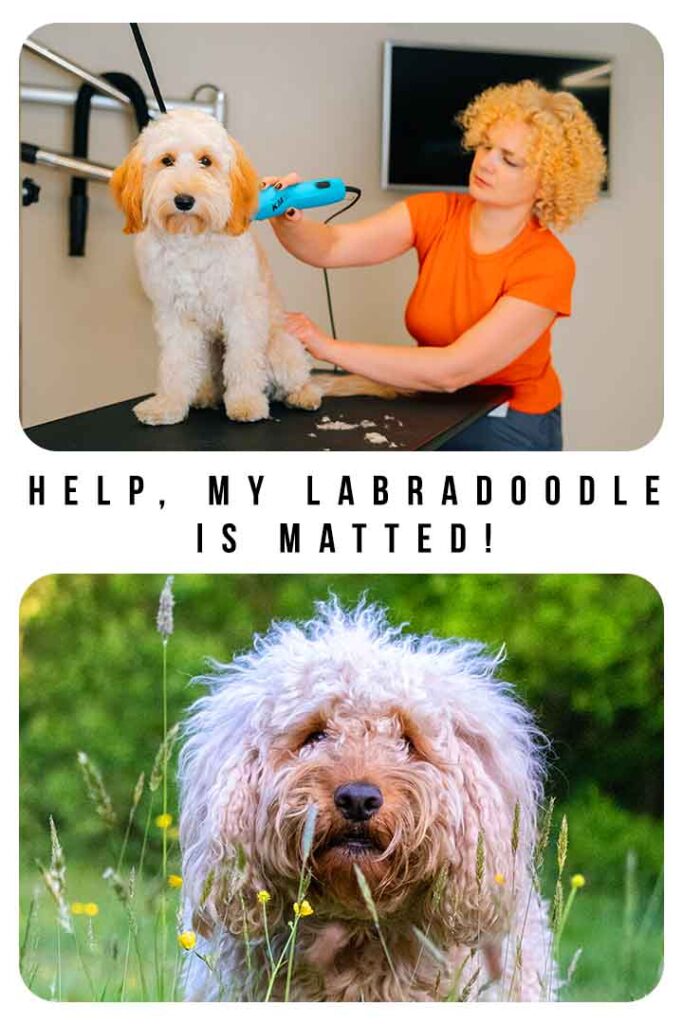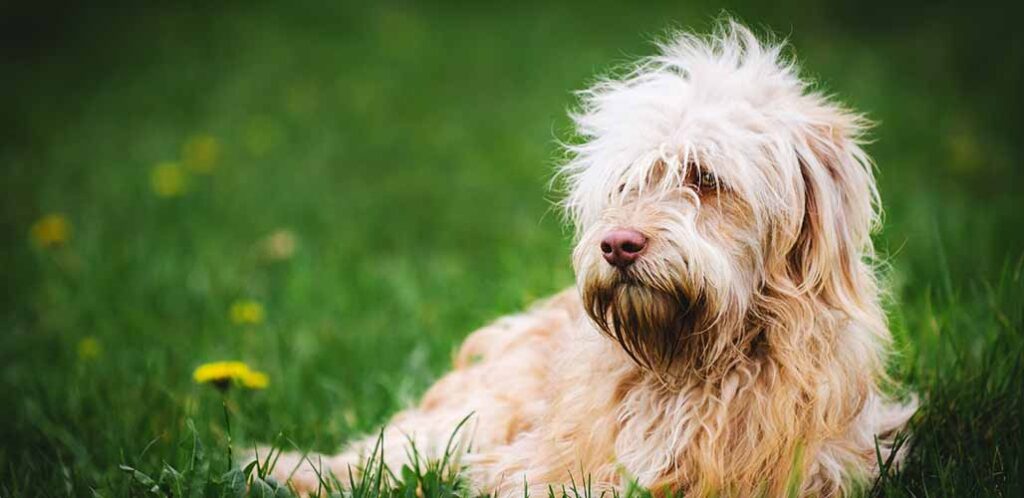When my Labradoodle is matted, I know it’s important to act fast. Getting tangles out of doodle’s fur is not a task which can wait until another day, as neglected knots cause pain, bruising, infections, overheating, and loss of circulation. In this article we’ve got a simple step by step explanation about what causes Labradoodle fur to mat, and how best to painlessly remove those tangles.
- My Labradoodle is matted – is this normal?
- Why is my Labradoodle matting?
- Is matted fur painful for dogs?
- How do you get mats out of Labradoodles?
- How do you detangle severely matted dog hair?
My Labradoodle is matted – is this normal?
As Labradoodles continue to gain popularity, veterinarians and groomers are increasingly reporting encounters with matted dogs. Curly coats are very prone to matting because the strands easily entwine around each other and get knotted in place.
Since the curly coat trait has a substantial degree of genetic dominance over the Labrador’s straight coat, most first generation Labradoodles also have some degree of waviness or curliness in their coat. This ‘wooly’ texture means that all Labradoodles can be affected by matting. But doodles with long, tightly curled coats inevitably seem to be more affected than doodles with relatively short, straight coats.
Whilst mats can form anywhere on their body, the first places they appear are usually where there is friction, such as
- under the collar
- under their ears
- inside their armpits
- between their toes
- on the back of their hind legs
- and on the underside of their tail.
Why is my Labradoodle matting?
At the simplest level, matting is caused by hairs getting rubbed together until they form a tangle. The normal movement of their body is enough to cause this in some places, as we’ve seen above. But some other factors can also increase the likelihood of finding mats in your dog’s coat, and how quickly they reappear after being brushed out:
- Not brushing frequently enough between grooms. Most Labradoodles need brushing at least every other day.
- Not brushing the coat deeply enough. Labradoodles need brushing until you can put a comb right down to the skin and draw it through their hair. Skimming just the surface of the coat won’t stop mats forming nearer the roots.
- Wearing a harness or sweater around the house, not just for walks.
- Overly frequently washing.
- Washing their coat without drying it completely using a blow dryer afterwards.
- Not drying their coat thoroughly after a wet walk or swim.
- Not removing dirt and debris picked up during walks, such as mud and burrs.

Another problem widely reported by groomers is new Labradoodle puppy parents receiving wrong advice from breeders about when to start brushing their dogs and taking them to the groomers. The answer is straight away! Not when they start losing their puppy coat, and not when they reach a year old – from the very beginning!
My Labradoodle is matted – but why now?
If you hadn’t been experiencing problems with mats before, but you are now, there are a couple of possible explanations.
- their adult coat coming through
- external changes
Their adult coat coming through
If they are between 6 and 12 months old, the culprit behind those tangles could be changes in their coat. Puppies are born with a soft fine coat, which gives way to a thicker, coarser coat as they grow up. This process is usually quite gradual, starting sometime after 6 months old. The problem is that as the baby coat is lost, the loose strands get caught and tangled in the curls of the remaining coat. Which makes them more easily prone to matting for a while.
External changes
Did the seasons change right before your doodle’s coat started matting? Did it start raining more frequently on your walks, or did it get warm enough to start swimming in a pond or stream? If your dog is getting wet more often, they are also at greater risk of matting.
Another explanation could be a change in shampoo, which is changing the texture of their coat. Consider anything which has changed in your dog’s life recently, and whether there could be a connection.
Is matted fur painful for dogs?
Yes, matted hair pulls and pinches against a dog’s skin, and causes them pain and discomfort. Untreated mats can also result in
- bruising
- hematomas (blood leaking and pooling outside of the blood vessels)
- ear infections
- bacterial, fungal and parasitic skin infections
- urine scalding if the mat traps pee against the skin
- difficulty pooping, which can develop into bowel obstruction
- and overheating during exercise.
In the most extreme cases, matted fur on their legs can even cut off the circulation, causing tissue death below that point. When this happens, sometimes the only course of action is to amputate the limb.
So clearly preventing mats and removing them promptly when they occur is vital. Let’s look at dematting now.
How do you get mats out of Labradoodles?
Don’t beat yourself up if you realize your Labradoodle has a mat in their coat. We’ve seen how easily it happens to curly coats. They’re extremely hard to avoid altogether, so what matters is that you’ve spotted it! If it isn’t too big, the chances are you’ll be able to remove it yourself too. Here are the steps, and some things to bear in mind as you work.
1. Gather your tools
Make sure you have everything you need to hand:
- slicker brush
- metal comb
- dematting comb, if you have one (if not, you’ll probably want one after this!)
- detangling spray
- round ended scissors (never scissors with pointed tips!)
- treats or a licki mat to secure your dog’s cooperation
2. Get in position
Make sure you’ve got a good view of the area you’re working on. Puppies and Miniature Labradoodles can be stood on a bench or table if you have someone else to hold them securely.
Try to take hold of the matted fur behind the mat, so that you don’t pull directly on the skin. If you can’t hold the fur, pull the skin taut with your other hand instead to reduce pulling.
3. Get started
Spray the mat with detangling spray and start teasing it out using the slicker brush, dematting tool, or your fingers. Work from the tips of the hair towards the root, until you can put a metal comb all the way down to their skin, and draw it through the area. If you can get under stubborn knots with round ended scissors you can snip them free.
4. Work patiently
Skin damage caused by over aggressive brushing is a common entry site for skin infections. Never attempt to force clippers through a mat. The best result is ruining your clippers. The worst is injuring your dog.
Finally, take frequent breaks. Dematting is an uncomfortable process, and it involves a lot of standing still, which doesn’t come naturally to dogs of action like Labradoodles!
How do you detangle severely matted dog hair?
If large areas of your dog’s coat are matted right down to the root, enlist a groomer to help you demat them. If you can’t afford a groomer, ask your veterinarian for help – severe matting is a serious welfare issue, and a vet may be able to offer a payment plan to cover the cost of treatment.
Sometimes severely matted dogs need to be shaved under sedation. The process can be painful when it pulls on the skin, and if the circulation has been cut off then restoring it is likely to be accompanied by serious pins and needles!
My Labradoodle is matted – summary
Curly coats are very prone to matting, so it’s unlikely that you’ll never discover a tangle in your doodle’s coat. It’s a good idea to check areas like their ears, armpits and the base of their tail regularly. The quicker you catch a mat the easier it is to remove. If your dog is so matted that you can’t find their skin, get urgent help from a groomer or veterinarian. And remember that it’s always worth the extra effort to brush them every day. Not only does this reduce the amount of matting you’ll encounter, it is calming and rewarding for your dog, and enhances your bond!
More about Labradoodle coats
- Understanding fleece coated Labradoodles
- Facts about flat coated Labradoodles
- Working out what kind of coat your dog has
- Does your Labradoodle need a sweater in winter?
- How to dry a dog after a bath
References
- McDonald et al. Grooming-Related Concerns Among Companion Animals: Preliminary Data on an Overlooked Topic and Considerations for Animals’ Access to Health-Related Services. Frontiers in Veterinary Science. 2022.
- Perry et al. Pseudomonas aeruginosa isolation from dog grooming products used by private owners or by professional pet grooming salons: prevalence and risk factors. Veterinary Dermatology. 2022.
- McGreevy et al. The reinforcing value of physical contact and the effect on canine heart rate of grooming in different anatomical areas. Anthrozoos. 2005.

